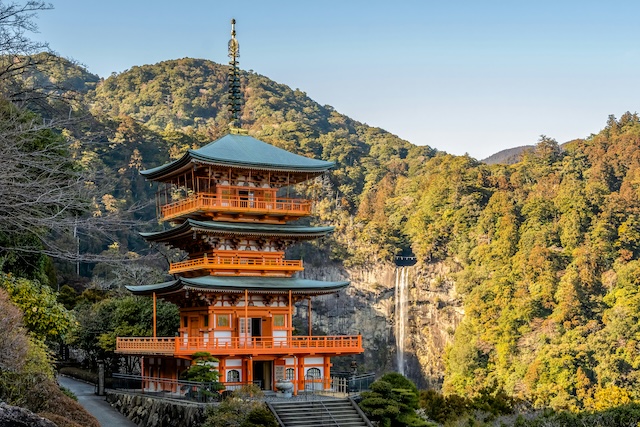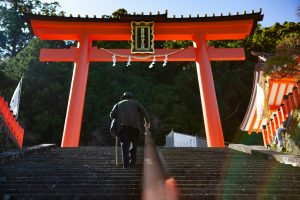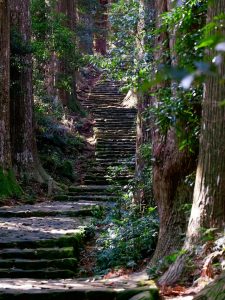Kumano Kodo: A Journey Along Japan’s Sacred Path
A Path of History and Faith: Overview of Kumano Kodo
Kumano Kodo, a historic pilgrimage route located on the Kii Peninsula of Japan, has been walked by countless people over the centuries, all aiming to reach the sacred Kumano Sanzan (Kumano Hongu Taisha, Kumano Hayatama Taisha, and Kumano Nachi Taisha). This pilgrimage route, inscribed as a UNESCO World Heritage site in 2004, attracts visitors with its beautiful natural scenery and rich cultural history. Kumano Kodo is not just a hiking trail but a spiritual journey that offers a deep dive into the cultural and religious depths of Japan.
Kumano Sanzan: The Heart of Mysticism and Faith
The journey along Kumano Kodo begins with the pilgrimage to Kumano Sanzan. At the heart of this pilgrimage is Kumano Hongu Taisha, revered as the spiritual center of Kumano faith, inspiring awe and reverence in visitors. Kumano Hayatama Taisha, located by the Kumano River, boasts a magnificent precinct harmonized with nature’s beauty. Kumano Nachi Taisha, situated alongside Japan’s highest waterfall, exudes a mystical aura that captivates all who visit. Each of these grand shrines has its own unique history and legends, offering visitors profound and moving experiences.
Harmony with Nature: The Seasonal Beauty of Kumano Kodo
Kumano Kodo is renowned for its stunning natural landscapes. The path weaves through lush f
orests, clear rivers, and rugged mountains, offering visitors the powerful and tranquil essence of nature. The changing seasons bring diverse scenery, with cherry blossoms and fresh greenery in spring, and vibrant autumn leaves in fall. This natural beauty, combined with historical monuments, create
s a picturesque space that symbolizes Japan’s culture and climate. Walking through this natural splendor refreshes both body and mind.
An Experiential Journey: Walking the Kumano Kodo
To truly appreciate Kumano Kodo, it’s best to walk the pilgrimage routes. There are several courses, catering to beginners and experienced hikers alike. The popular Nakahechi route offers relatively easy walking with beautiful scenery and historical sites. For those seeking a challenge, the rugged Omine Okugake Michi offers a rewarding and fulfilling experience. Guided tours are available, providing in-depth knowledge about the history and nature along the way, enhancing the overall experience.
Embracing Local Culture: Enjoying Hot Springs and Cuisine
A journey along Kumano Kodo also offers opportunities to experience local culture and cuisine. After a long walk, soaking in a hot spring is a perfect way to relax and rejuvenate. Near Kumano Hongu Taisha, Kawayu Onsen offers a unique experience with natural hot springs bubbling up in the river. Local cuisine, featuring fresh seafood and mountain produce, is another highlight. The warm and rustic hospitality of the Kumano region enhances the travel experience, leaving lasting memories.
Access and Accommodation Information for Kumano Kodo
Access to Kumano Kodo is typically via Kii-Tanabe Station or Shingu Station. From Tokyo or Osaka, you can take the Shinkansen or express trains to reach these starting points. Local buses and taxis are available to take you to the various trailheads. Accommodation options along the route range from traditional inns and guesthouses to resort hotels, catering to various budgets and preferences. Staying in local accommodations allows you to experience the traditional lifestyle and hospitality of the region.
Conclusion: Experiencing the Essence of Japan on Kumano Kodo
Kumano Kodo is a special place where Japan’s history, culture, and nature intertwine. Walking the pilgrimage routes allows visitors to fully immerse themselves in Japan’s ancient faith and the beauty of its natural landscapes. Offering moments of quiet prayer and the rejuvenation of being surrounded by nature, this journey provides a unique escape from everyday life. For foreign visitors to Japan, Kumano Kodo offers an exceptional experience, allowing them to fully enjoy the profound charm of this sacred path.



